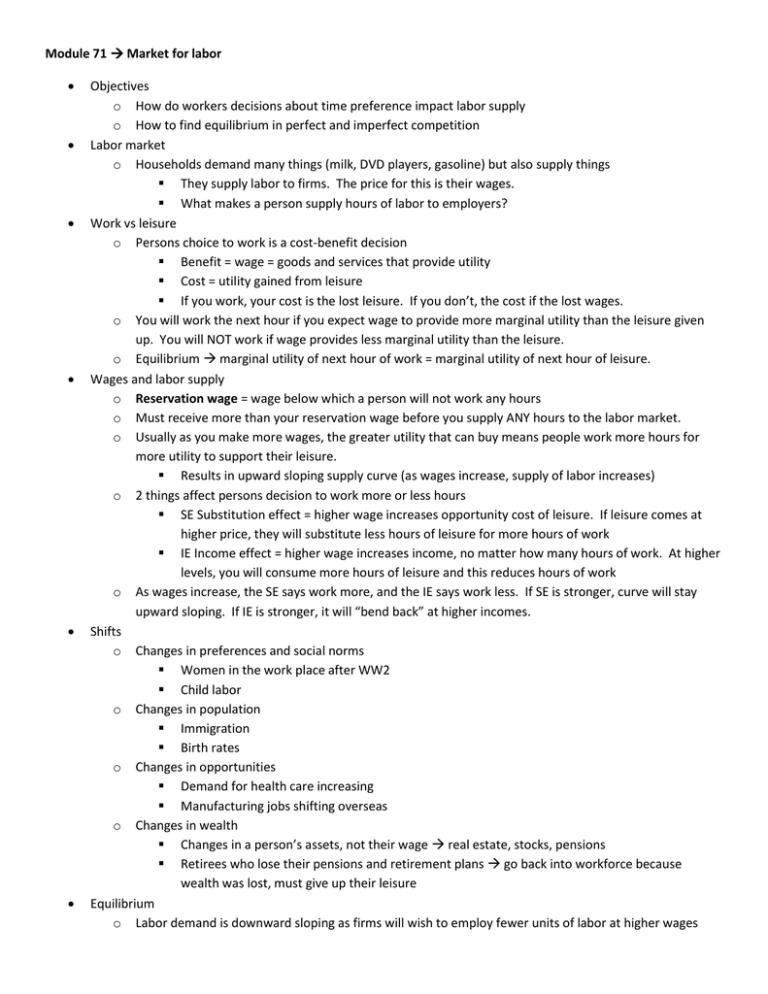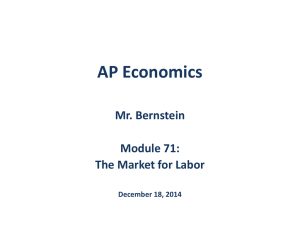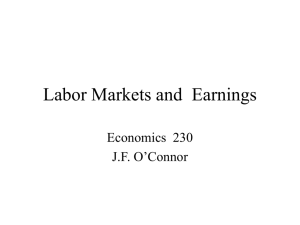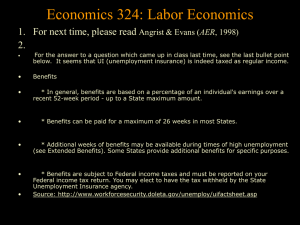Module 71 à Market for labor Objectives How do workers decisions
advertisement

Module 71 Market for labor Objectives o How do workers decisions about time preference impact labor supply o How to find equilibrium in perfect and imperfect competition Labor market o Households demand many things (milk, DVD players, gasoline) but also supply things They supply labor to firms. The price for this is their wages. What makes a person supply hours of labor to employers? Work vs leisure o Persons choice to work is a cost-benefit decision Benefit = wage = goods and services that provide utility Cost = utility gained from leisure If you work, your cost is the lost leisure. If you don’t, the cost if the lost wages. o You will work the next hour if you expect wage to provide more marginal utility than the leisure given up. You will NOT work if wage provides less marginal utility than the leisure. o Equilibrium marginal utility of next hour of work = marginal utility of next hour of leisure. Wages and labor supply o Reservation wage = wage below which a person will not work any hours o Must receive more than your reservation wage before you supply ANY hours to the labor market. o Usually as you make more wages, the greater utility that can buy means people work more hours for more utility to support their leisure. Results in upward sloping supply curve (as wages increase, supply of labor increases) o 2 things affect persons decision to work more or less hours SE Substitution effect = higher wage increases opportunity cost of leisure. If leisure comes at higher price, they will substitute less hours of leisure for more hours of work IE Income effect = higher wage increases income, no matter how many hours of work. At higher levels, you will consume more hours of leisure and this reduces hours of work o As wages increase, the SE says work more, and the IE says work less. If SE is stronger, curve will stay upward sloping. If IE is stronger, it will “bend back” at higher incomes. Shifts o Changes in preferences and social norms Women in the work place after WW2 Child labor o Changes in population Immigration Birth rates o Changes in opportunities Demand for health care increasing Manufacturing jobs shifting overseas o Changes in wealth Changes in a person’s assets, not their wage real estate, stocks, pensions Retirees who lose their pensions and retirement plans go back into workforce because wealth was lost, must give up their leisure Equilibrium o Labor demand is downward sloping as firms will wish to employ fewer units of labor at higher wages o Labor supply is upward sloping as people will wish to offer more units of labor at higher wages o Equilibrium is at the only wage where quantity of labor supplied equals quantity of labor demanded o Wage (W*) equals value of marginal product (VMP) of the last unit of labor hired o Graphing: vertical axis = W; horizontal axis = quantity of labor When product market is not perfectly competitive o When firms are price makers, price must be lowered to increase quantity sold. Price of last unit sold is greater than marginal revenue from selling it Perfect P=MR (price taking) Imperfect P>MR (price setting) o In hiring, in a perfect market VMPL = P * MPL = W. Hire until VMPL=W. In imperfect market, marginal dollars of benefit received is not due to price (P) but due to marginal revenue (MR). MRPL = MR * MPL = W. Hire until MRPL=W. Because MR<P, MRPL<VMPL Graphed, both are downward sloping, but MRPL is below VMPL. Demand in imperfect market is less than demand in perfect competition. Fewer workers will be employed. When labor market is not perfectly competitive o Additional cost of hiring next unit of labor marginal factor cost of labor (MFCL) o What if instead of many small firms, there is 1 large firm in the market? When it hired more labor, it must offer higher wages to attract them. Because labor supply curve is upward sloping. o Wage must be increased for all units of labor. MFCL rises as more workers are hired. MFCL>W. o Why? This is confusing. It just is. <page 326 in the binder> o When you hire a new employee you have to pay more, then also pay your existing employees the same amount more. Equilibrium in imperfect labor market o When both product market and labor market are imperfect, how many units of labor will firm employ? o Hire up to the point where additional dollars of revenue earned equals additional dollars of labor cost incurred o Hire E* units of labor where: MRPL=MFCL o What is E? consult labor supply curve at employment level E*. o Wage will be below MRP dollars their work brings to the firm. Not surprising, as they might be the only employer in the local market. They can pay lower wages than they would if market was competitive.








